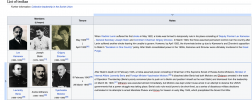Nazi Space Spy
Banned
How does Ron Paul end up being from NH? He was already a member of Congress from Texas before the POD of this. Great work none the less!The Sixth Party System: The Success of John B. AndersonNote: This was just something that popped into my head earlier today. I didn't put too much thought into how John B. Anderson wins the 1980 election. This was just something I thought would be interesting. I am also already aware that Paul's death date shows both 2019 and 2020. Mistake on my part, but the 2020 one is correct. I did my best to avoid any Current Political Figures, though if I got one, let me know.

Political Parties:
Democratic Party (#1c3ffd) - The Legacy of Franklin Roosevelt and Lyndon Johnson. Democrats have moved to the political left thanks to the political leadership of Presidents Gore, Richards, and Brown. Democratic Socialist to social democrat, most of the conservatives in the party left for either the Republican or Liberal Party. Its political claim to fame as of the early 21st century is its progress on environmental and conservationist projects. It's strength is in the West Coast states, Hawaii, West Virginia, and the larger cities in the United States like New York, Pennsylvania, and Boston. They most recently ran the presidential ticket of Steve Beshear (D-KY)/Ralph Nader (D-CT).
Republican Party (#ff2d00) - The Legacy of Barry Goldwater and Ronald Reagan. Has moved increasingly farther to the right. Reagan loosing to Anderson would lead to him becoming a Senator from California, leading the Conservative charge in his party from 1983 until his resignation in 1994 with the diagnosis of his Alzheimer's disease. His conservative leadership would be taken up by Texas Representative Ron Paul. Most of the most conservative Democrats would join the Republican Party. Strongest support comes from the Great Plains, Midwest and Southern States. Most recent presidential ticket was George Bush (R-TX)/Jim Gilmore (R-VA)
Liberal Party (#ff0081) - The Legacy of the Dwight Eisenhower and George W. Romney. Born out of the Presidency of John B. Anderson, the Liberal Party would take the moderates of both parties. Though it originally was the home of Rockefeller Republicans, it would grow to include some of the slightly conservative branch of the Democratic Party. Claims to be the party of common sense and compromise. While one of the smallest parties in Congress, most bills do not get passed without some watering down/additions by the Liberal Party. The strongest support for the party comes from the New England States, New York, Delaware, Illinois, and Maryland. It also holds a hefty sway over the local politics of Kentucky and Texas. Its most recent presidential ticket was Christine Todd Whitman (L-NJ)/William Weld (L-MA).
Elections:
1980-1988: John B. Anderson (I/LR-IL)/Patrick Lucey (I/L-WI)
1980 def. Ronald Reagan (R-CA)/George H. Bush (R-TX), Jimmy Carter (D-GA)/Walter Mondale (D-MN)
1984 def. John Connally (R-TX)/Phil Crane (R-IL), John Glenn (D-OH)/Gary Hart (D-CO)
1988-1992: Patrick Lucey (L-WI)/Edward Brooke (L-MA)
1988 def. Harold Stassen (R-MN)/Paul Laxalt (R-NV), Michael Dukakis (D-MA)/Geraldine Ferraro (D-NY)
1992-2000: Al Gore (D-TN)/Richard Lamm (D-CO)
1992 def. Patrick Lucey (L-WI)/Edward Brooke (L-MA), George H. Bush (R-TX)/Pat Buchanan(R-VA)
1996 def. Pat Buchanan(R-VA)/Lamar Alexander (R-TN), Lowell Weicker (L-CT)/Paul Simon (L-IL)
2001-2006: Ann Richards (D-TX)/Jerry Brown (D-CA)
2000 def. John McCain (R-AZ)/Newt Gingrich (R-GA), George Pataki (L-NY)/Scott Brown (L-MA)
2004 def. Fred Thompson (R-TN)/Newt Gingrich (R-GA), Mike Castle (L-DE)/Dede Scozzafava (L-NY)
2006-2017: Jerry Brown (D-CA)/Peter DeFazio (D-OR)
2008 def. Newt Gingrich (R-GA)/Duncan L. Hunter (R-CA), Buddy Roemer (L-LA)/Fred Karger (L-CA)
2012 def. Colin Powell (R-MD)/Elliott Abrams (R-NY), Ben Chandler (L-KY)/Joe Baca (L-CA)
2017-2020: Ron Paul (R-NH)/George Bush (R-TX)
2016 def. Peter DeFazio (D-OR)/Christine Gregoire (D-WA), John Barrow (L-GA)/Mike Michaud (L-ME)
2020: George Bush (R-TX)/vacant
2020-present: Christine Todd Whitman (L-NJ)/William Weld (L-MA)
2020 def. George Bush (R-TX)/Jim Gilmore (R-VA), Steve Beshear (D-KY)/Ralph Nader (D-CT)

